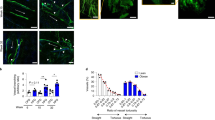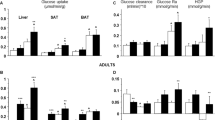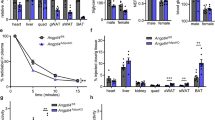Abstract
The aim of this study was to investigate subcutaneous adipose tissue lymphatic drainage (ATLD) of macromolecules in lean and obese subjects and, furthermore, to evaluate whether ATLD may change in parallel with adipose tissue blood flow. Lean and obese male subjects were studied before and after an oral glucose load. Adipose-tissue blood flow was measured in the anterior subcutaneous abdominal adipose tissue by the 133Xe-washout technique. ATLD was measured as the disappearance rate of 99mTc-labelled nanoaggregated human albumin, during fasting and after an oral glucose load. A significant increase in ATLD was seen after the glucose load in the lean subjects. In the obese subjects, ATLD remained constant throughout the study and was significantly lower compared to the lean subjects. These results indicate a reduced ability to remove macromolecules from the interstitial space through the lymphatic system in obese subjects. Furthermore, they suggest that postprandial changes in ATLD taking place in lean subjects are not observed in obese subjects. This may have a role in the development of obesity-related inflammation in hypertrophic adipose tissue.
This is a preview of subscription content, access via your institution
Access options
Subscribe to this journal
Receive 12 print issues and online access
$259.00 per year
only $21.58 per issue
Buy this article
- Purchase on Springer Link
- Instant access to full article PDF
Prices may be subject to local taxes which are calculated during checkout


Similar content being viewed by others
References
Ouchi N, Parker JL, Lugus JJ, Walsh K . Adipokines in inflammation and metabolic disease. Nat Rev Immunol 2011; 11: 85–97.
Dalmas E, Clément K, Guerre-Millo M . Defining macrophage phenotype and function in adipose tissue. Trends Immunol 2011; 32: 307–314.
Mohamed-Ali V, Goodrick S, Rawesh A, Katz DR, Miles JM, Yudkin JS et al. Subcutaneous adipose tissue releases interleukin-6, but not tumor necrosis factor-α, in vivo. J Clin Endocrinol Metab 1997; 82: 4196–4200.
Clausen TS, Kaastrup P, Stallknecht B . Proinflammatory tissue response and recovery of adipokines during 4 days of subcutaneous large-pore microdialysis. J Pharmacol Toxicol Methods 2009; 60: 281–287.
Miller NE, Michel CC, Nanjee MN, Olszewski WL, Miller IP, Hazell M et al. Secretion of adipokines by human adipose tissue in vivo: partitioning between capillary and lymphatic transport. Am J Physiol Endocrinol Metab 2011; 301: 659–667.
Summers LKM, Samra JS, Humphreys SM, Morris RJ, Frayn KN . Subcutaneous abdominal adipose tissue blood flow: variation within and between subjects and relationship to obesity. Clin Sci 1996; 91: 679–683.
Tobin L, Simonsen L, Bülow J . Real-time contrast-enhanced ultrasound determination of microvascular blood volume in abdominal subcutaneous adipose tissue in man. Evidence for adipose tissue capillary recruitment. Clin Physiol Funct Imaging 2010; 30: 447–452.
Jensen MR, Simonsen L, Karlsmark T, Bülow J . Lymphoedema of the lower extremities -background, pathophysiology and diagnostic considerations. Clin Physiol Funct Imaging 2010; 30: 389–398.
Simonsen L, Enevoldsen LH, Bülow J . Determination of adipose tissue blood flow with local 133Xe clearance. Evaluation of a new labelling technique. Clin Physiol Funct Imaging 2003; 23: 320–323.
Bülow J, Jelnes R, Astrup A, Madsen J, Vilmann P . Tissue/blood partition coefficients for xenon in various adipose tissue depots in man. Scand J Clin Lab Invest 1987; 47: 1–3.
Spencer M, Unal R, Zhu B, Rasouli N, McGehee RE, Peterson CA et al. Adipose tissue extracellular matrix and vascular abnormalities in obesity and insulin resistance. J Clin Endocrinol Metab 2011; 96: 1990–1998.
Divoux A, Clément K . Architecture and the extracellular matrix: the still unappreciated components of the adipose tissue. Obes Rev 2011; 12: 494–503.
Uzarski J, Drelles MB, Gibbs SE, Ongstad EL, Goral JC, McKeown KK et al. The resolution of lymphedema by interstitial flow in the mouse tail skin. Am J Physiol Heart Circ Physiol 2008; 294: 1326–1334.
Tobin L, Simonsen L, Bülow J . The dynamics of the microcirculation in the subcutaneous adipose tissue is impaired in the postprandial state in type 2 diabetes. Clin Physiol Funct Imaging 2011; 31: 458–463.
Acknowledgements
This study received financial support from the Novo Nordic Foundation.
Author information
Authors and Affiliations
Corresponding author
Ethics declarations
Competing interests
The authors declare no conflict of interest.
Rights and permissions
About this article
Cite this article
Arngrim, N., Simonsen, L., Holst, J. et al. Reduced adipose tissue lymphatic drainage of macromolecules in obese subjects: a possible link between obesity and local tissue inflammation?. Int J Obes 37, 748–750 (2013). https://doi.org/10.1038/ijo.2012.98
Received:
Revised:
Accepted:
Published:
Issue Date:
DOI: https://doi.org/10.1038/ijo.2012.98
Keywords
This article is cited by
-
Repository Describing the Anatomical, Physiological, and Biological Changes in an Obese Population to Inform Physiologically Based Pharmacokinetic Models
Clinical Pharmacokinetics (2022)
-
High-fat diet induced central adiposity (visceral fat) is associated with increased fibrosis and decreased immune cellularity of the mesenteric lymph node in mice
European Journal of Nutrition (2020)
-
Inhibition of Inflammation and iNOS Improves Lymphatic Function in Obesity
Scientific Reports (2016)
-
From sewer to saviour — targeting the lymphatic system to promote drug exposure and activity
Nature Reviews Drug Discovery (2015)
-
Lymphatic Function Regulates Contact Hypersensitivity Dermatitis in Obesity
Journal of Investigative Dermatology (2015)



